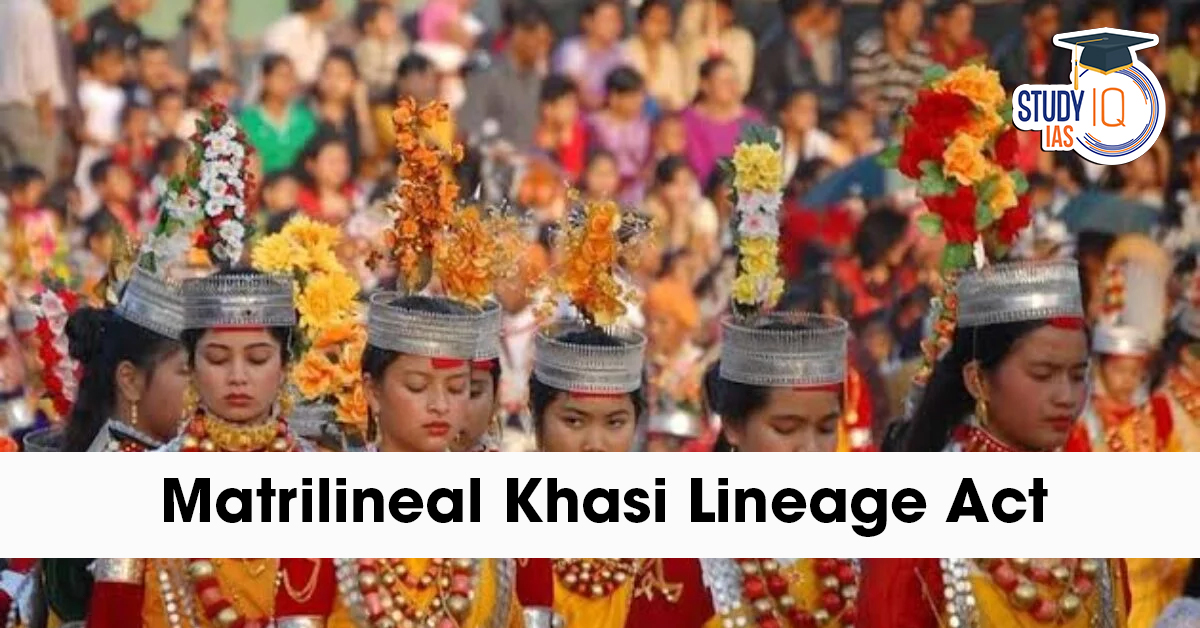Table of Contents
Context
The Meghalaya High Court is currently hearing a petition challenging the constitutional validity of a law passed by the Khasi Hills Autonomous District Council (KHADC). The law denies Scheduled Tribe (ST) certificates to Khasi individuals who use their father’s or husband’s surname, citing a violation of the matrilineal structure. This case brings attention to the Matrilineal Khasi Lineage Act and its impact on tribal identity, inheritance, and access to benefits in the Khasi Hills Autonomous District of Meghalaya.
What is the Matrilineal Khasi Lineage Act?
-
Enacted By: Khasi Hills Autonomous District Council (KHADC)
-
Purpose:
-
To preserve the matrilineal customs of the Khasi tribe.
-
To prevent misuse of tribal status for government benefits.
-
-
Jurisdiction:
-
Applicable only within the Khasi Hills Autonomous District, one of the three autonomous councils in Meghalaya under the Sixth Schedule of the Indian Constitution.
-
Core Principle: Matrilineality
The Khasi tribe is one of the few matrilineal societies in the world.
-
Lineage, inheritance, identity, and clan are traced through the mother, not the father.
-
Children take the mother’s clan name, known as Kur or Jait.
-
Property is traditionally inherited by the youngest daughter (Ka Khadduh).
Who is Legally Considered a Khasi?
The Act lays down strict conditions for recognizing a person as Khasi.
| Parentage | Conditions to be Recognized as Khasi |
|---|---|
| Both Parents Khasi | Child is Khasi (inherits mother’s clan name) |
| Mother Khasi + Father Non-Khasi | Child is Khasi only if: • Speaks Khasi • Follows matrilineal inheritance and customs • Has not adopted father’s surname or personal law |
| Father Khasi + Mother Non-Khasi | Child is not Khasi by birth. Must undergo Tang Jait ceremony to be inducted into a Khasi clan. |
Important Ceremonies: Tang Jait and Rapiing
-
Tang Jait Ceremony
-
A formal ritual for adopting a child into the mother’s clan.
-
Especially used when the father is Khasi and the mother is not.
-
Allows the child to be recognized as Khasi after proper clan affiliation.
-
-
Rapiing Ceremony
-
In rare cases where female lineage dies out, a woman from another clan may be adopted into a family to continue the matrilineal legacy.
-
Loss of Khasi Status: When Does It Happen?
An individual may lose their Khasi identity and associated benefits if they:
-
Renounce Khasi matrilineal customs.
-
Use the father’s surname instead of the mother’s clan name.
-
Adopt non-Khasi personal laws or cultural practices.
Consequences of losing Khasi status:
-
No access to tribal property rights.
-
Disqualification from Scheduled Tribe (ST) benefits like reservation.
-
Loss of clan identity affects community belonging.
Rules for Changing Surname or Clan Name
-
Changing the surname to anything other than the mother’s Kur name is not allowed by default.
-
Process includes:
-
Filing an official petition to KHADC.
-
Publishing a public notice.
-
Undergoing verification by local traditional institutions.
-
-
Clan name must conform to Khasi matrilineal customs.
Legal Challenge & Constitutional Questions
The petition before the Meghalaya High Court argues that:
-
The law violates individual rights under Article 14 (Equality) and Article 21 (Right to Life & Dignity).
-
Denial of ST certificate based on surname is discriminatory.
-
It imposes collective cultural identity over personal autonomy.
However, the KHADC and supporters argue that:
-
It is necessary to protect the cultural integrity of the Khasi tribe.
-
Prevents non-tribals from exploiting ST benefits by marrying into the tribe without adopting its customs.
Broader Significance
-
The Khasi Lineage Act reflects the complex intersection of tradition and modern law.
-
It highlights tensions between tribal autonomy under the Sixth Schedule and individual constitutional rights.
-
Raises critical questions for policymakers:
-
Should tribal customs be preserved even if they restrict personal freedom?
-
Can identity and benefits be linked to cultural conformity?
-
Conclusion
The Matrilineal Khasi Lineage Act is not just a tribal law—it is a cultural safeguard for one of India’s most unique societies. But as Meghalaya’s courts examine its fairness and constitutionality, India must grapple with a critical dilemma: how to balance tribal identity and constitutional equality in a rapidly evolving democracy.


 Protection of the Aravalli Range: Import...
Protection of the Aravalli Range: Import...
 Viksit Bharat Shiksha Adhishthan Bill 20...
Viksit Bharat Shiksha Adhishthan Bill 20...
 Jumping Genes: The Revolutionary Discove...
Jumping Genes: The Revolutionary Discove...

























